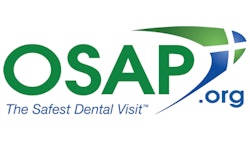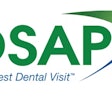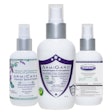
One of the biggest discussion points in 2020 has been how to reduce aerosols in the dental practice to help mitigate the spread of COVID-19. With that in mind, here are five tips to control aerosols in your practice.
Tip 1
Always use proper personal protective equipment (PPE) to protect yourself and your patient. Be certain that your mask has the proper amount of filtration to stop aerosols and splatter. ADA guidance calls for N95 masks, with a positive seal around the nose and mouth, in combination with a full face shield.
 Dr. Joe Blaes.
Dr. Joe Blaes.Tip 2
Always follow infection control guidelines from the ADA, the Organization for Safety, Asepsis and Prevention (OSAP), and the Occupational Safety and Health Administration (OSHA).
Tip 3
One of the best ways to protect the dental team doing restorative dentistry is using a rubber dam for every procedure. I have been using a rubber dam in my practice from the very beginning thanks to my mentor, Dr. Roy Wolff, who insisted that I use one for every procedure. He also taught me some shortcuts that made placing a rubber dam much easier for me and the patient.
First of all, do quadrant dentistry and isolate all the teeth in a quadrant. I do not punch one hole for each tooth. I punch a series of connected holes in the rubber dam. Place a rubber dam clamp on the most distal tooth in the quadrant. Place a small amount of lubricant around the series of holes. Put the rubber dam over the clamp and stretch it forward to the cuspid and secure it by pulling it through the cuspid/lateral contact. Train your dental assistant to help with the placement of the dam (four hands make it easier than two). Place a rubber dam napkin and then stretch the dam onto the rubber dam holder and you are ready to prep teeth with no worry of cutting the dam in the interproximal area.
The rubber dam seals off the rest of the mouth which inhibits being exposed to the virus and bacteria in the mouth. Please notice in figure 4 below that my patient is wearing a nitrous oxide sedation mask. My patients love to go to their relaxed happy place. For more information, I suggest contacting DOCS Education.
 All images courtesy of Dr. Joe Blaes.
All images courtesy of Dr. Joe Blaes.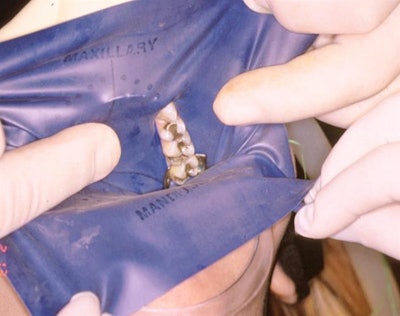
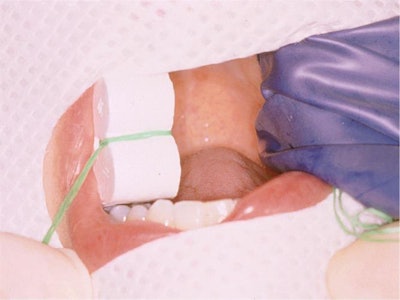

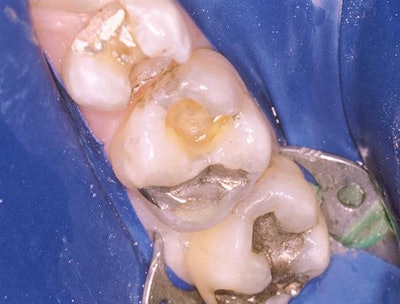
Tip 4
My dental assistant always uses the high-volume evacuator (HVE) and controls most of the aerosols by drawing horizontal across the occlusal plane. To determine that your HVE is working adequately, all you need is to fill a container with five cups of tap water, then turn off your HVE in all of your treatment rooms. Go to your main treatment room, turn on the HVE, and put the tip into the water-filled container. It should be emptied in eight seconds. If your HVE takes longer than this, you have a problem that needs attention!
Tip 5
I do most of my restorative dentistry air prepping teeth without the water spray, continuing to use the coolant air to cool the tooth. I use a disposable sharp diamond or bur for every patient. Using this procedure in the mouth produces dust, debris, and an odor that must be removed by the high-volume evacuator. Also, the HVE suction is actually cooling the tooth as well. I have been using an electric handpiece for more than 30 years. I have used many different brands, but my favorite is the Bien-Air Evo.15 electric handpiece. This has a patented "cool touch" push button, with heat-arresting technology that prevents any burns to my patients or my thumb. Because this electric handpiece does not heat up, we can prep teeth with no water spray and no aerosols.
While air prepping, it is important to limit bur contact time to 20-second intervals.
Dr. Joe Blaes created a unique, insurance-free, fee-for-service general practice in St. Louis that emphasizes preventive, esthetic, reconstructive, and implant dentistry. He is best known as the former chief editor of Dental Economics. Blaes is a fellow of the American College of Dentists, a past president of the American Academy of Dental Practice Administration, and a founding member of the American Academy for Oral Systemic Health. He can be reached at [email protected].
The comments and observations expressed herein do not necessarily reflect the opinions of DrBicuspid.com, nor should they be construed as an endorsement or admonishment of any particular idea, vendor, or organization.





